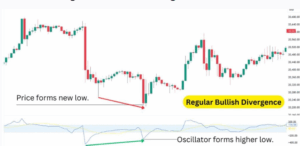If you’ve ever stared at your forex charts and thought, “Why is the price going one way and my indicator another?”—you’ve already brushed shoulders with divergence. It’s one of those trading concepts that, once you understand, can feel like a cheat code. Traders often use divergence as an early sign of a potential reversal or continuation in the market. But before you rush into using it, let’s break it down into plain English.
At its core, divergence happens when the price of a currency pair and a technical indicator (like the RSI or MACD) move in opposite directions. Imagine watching a boxer step forward, but their shadow moves backward—that’s divergence. It signals something’s off and a change might be on the horizon.
Why do traders care so much about divergence? Because it gives you a clue—not a guarantee—that price may slow down, reverse, or continue in a hidden trend. It’s a way to read between the lines of price action. And best of all, it works across all timeframes and pairs.
To spot divergence clearly, it helps to draw swings and set indicator alerts as you go. I like using TradingView to overlay RSI/MACD, mark highs/lows, and trigger alerts when conditions line up.
There are two main types to know:
- Regular Divergence: Usually hints at a potential reversal.
- Hidden Divergence: Often signals a possible trend continuation.


You don’t need to be a charting wizard to use divergence effectively. But you do need a cheat sheet—something to make it stick. That’s what this article is all about.
Forex Divergence Types: A Quick Cheat Sheet
When it comes to spotting divergence, knowing the differences can save you from making rookie mistakes. Here’s a simple table to help you identify the types of divergence and what they’re trying to tell you.
| Divergence Type | Price Action | Indicator Action (RSI/MACD) | Likely Signal | Use Case |
| Regular Bullish | Lower Lows | Higher Lows | Trend Reversal (Uptrend) | Good after a downtrend |
| Regular Bearish | Higher Highs | Lower Highs | Trend Reversal (Downtrend) | Good after an uptrend |
| Hidden Bullish | Higher Lows | Lower Lows | Trend Continuation (Uptrend) | Confirms ongoing uptrend |
| Hidden Bearish | Lower Highs | Higher Highs | Trend Continuation (Downtrend) | Confirms ongoing downtrend |
Quick Tip: RSI and MACD are your go-to indicators for spotting divergence. Stick with them as you learn—they’re reliable and widely used.
Want an extra filter when RSI/MACD signals look borderline? Vip Indicators can highlight momentum shifts and help you avoid weaker divergence setups.
How to Spot and Use Forex Divergence (Step-by-Step List)
If the table felt a little too much like school, don’t worry—here’s a more relaxed, step-by-step breakdown of how to actually use divergence while trading:
- Pick Your Indicator
Start simple. Use the Relative Strength Index (RSI) or MACD. These two are beginner-friendly and widely trusted.
- Zoom Out First
Check the overall trend direction on a higher timeframe. If the pair has been in a downtrend, regular bullish divergence might indicate a bounce. If it’s an uptrend, hidden bullish divergence might mean more upside.
- Find the Price Pattern
Look for higher highs, lower lows, or other meaningful swings on your chart. Don’t force it. Divergence only matters at key turning points.
- Compare to the Indicator
See what the RSI or MACD is doing at those same price levels. Are they showing the opposite of what price is doing?
- Price making lower lows but RSI showing higher lows? That’s regular bullish divergence.
- Price making higher highs but MACD showing lower highs? That’s regular bearish divergence.
- Confirm with Price Action
Divergence isn’t enough. Wait for a confirmation candle, a break of structure, or even a trendline break before entering.
If you’d rather let software watch for your confirmation rules (e.g., candle close or structure break) and execute, WallStreet Forex Robot 3.0 can help automate divergence-based plans so you’re not glued to the screen.
- Set Smart Entries and Stops
Enter once you have confirmation—not just when divergence appears. Set a stop loss below the swing low (for long) or above the swing high (for short).
- Practice, Not Predict
Divergence isn’t a magic crystal ball. Use it as a tool in your kit, not the whole kit. Practice spotting it in different conditions before trading it live.
FAQs About Forex Divergence
Can divergence happen without a trend?
It can—but it’s usually weaker. Divergence works best when there’s a clear trend and the market shows signs of exhaustion or continuation.
What’s the best timeframe to use divergence?
Divergence works on all timeframes, but the higher the timeframe, the stronger the signal. It’s more reliable on 1-hour and above.
Is divergence a lagging or leading indicator?
It’s somewhere in between. It gives you an early warning, but you still need confirmation. It’s not predictive—it’s suggestive.
Should I use RSI or MACD for divergence?
Use both! RSI is simpler and reacts quicker. MACD gives more in-depth info. Try both and stick with the one that fits your trading style.
What’s the biggest mistake traders make with divergence?
Jumping in without confirmation. Just because you see divergence doesn’t mean you act on it immediately.
Conclusion: Mastering Divergence Without Overthinking It
The truth? Forex divergence isn’t hard. But it does require practice, patience, and a little bit of chart-watching discipline. It’s a subtle signal—like a whisper from the market. If you train yourself to listen, you’ll catch shifts before most traders even notice them.
Start with RSI or MACD, spot those regular and hidden divergence patterns, and always wait for price to confirm what your indicator is hinting at. Use the cheat sheet table as your daily companion until recognizing divergence becomes second nature.
In forex, there are no silver
